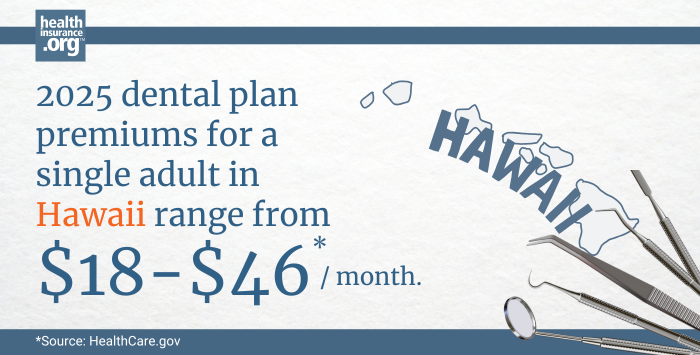Home > Dental Insurance > Hawaii
Find a dental plan in Hawaii that’s right for you.

Need dental coverage in Hawaii? Explore options by entering your zip code and connect with a licensed insurance agency.

Hawaii dental insurance guide
Hawaii’s health insurance Marketplace has certified individual and family dental plans from three insurers
Hawaii uses the federally-run health insurance Marketplace at HealthCare.gov for the sale of certified individual/family dental plans.
None of the insurers that offer medical plans through the Hawaii health insurance exchange embed dental coverage in their health plans.1 But stand-alone dental plans are available for purchase that cover both adults and children.
Frequently asked questions about dental coverage in Hawaii
How much does dental insurance cost in Hawaii?
For adults who purchase their own stand-alone dental coverage through the exchange in Hawaii, premiums in 2025 range from about $18 to $46 per month.2

If a family is purchasing coverage through the health insurance exchange, the premiums associated with pediatric dental coverage may or may not be offset by premium tax credits (premium subsidies). Here’s more about how that works, depending on whether the health plan has integrated pediatric dental benefits.
Are stand-alone pediatric dental plans on the exchange ACA-compliant?
None of the insurers that offer medical plans through the Hawaii exchange include dental coverage with their health plans, 1 so a stand-alone dental plan is the only way to obtain pediatric (or adult) dental benefits in Hawaii’s exchange/Marketplace. But all of the stand-alone dental plans available through the Marketplace will comply with the ACA’s pediatric dental coverage rules.
This means out-of-pocket costs for pediatric dental care will not exceed $400 per child in 2024 (or $800 for all the children on a family’s plan),3 and there is no cap on medically necessary pediatric dental benefits. (For 2025, the out-of-pocket maximums will increase to $425 and $850, respectively.4)
As is the case for all essential health benefits, the specific coverage requirements for pediatric dental care are guided by the state’s essential health benefits benchmark plan.
You can see details here for the Hawaii benchmark plan, which includes coverage for both basic and major dental services for children.
Which insurers offer dental coverage through the Hawaii marketplace?
In 2025, three insurers offer stand-alone individual/family dental coverage through the health insurance marketplace in Hawaii.5 These are dental plans that are not included with a medical plan and must be purchased separately.*
- BEST Life
- Hawaii Dental Service
- HMSA
*Plans from insurers may not be offered in all areas.
This coverage can be purchased through HealthCare.gov during open enrollment (November 1 to January 15) or during a special enrollment period triggered by a qualifying life event. Exchange-certified stand-alone dental plans are compliant with the ACA’s rules for pediatric dental coverage.
Can I buy dental insurance outside of Hawaii's exchange?
There are also a variety of dental insurers that sell stand-alone dental plans directly to consumers in Hawaii. These plans are not subject to the ACA’s essential health benefit rules for pediatric dental coverage, but they are regulated by the Hawaii Department of Commerce and Consumer Affairs. If you would like to purchase a non-ACA qualified dental plan, ask a dentist for recommendations or search online.
In Hawaii, there are also various dental discount plans available. Dental discount plans are not insurance, but can offer discounted rates at participating dentists. Learn about the differences between dental insurance and dental discount plans.
To find plans in your area, search online for dental discount plans and the state you are looking to buy a plan in.
How does Hawaii Medicaid and CHIP provide dental coverage?
Thanks to legislation passed in 2022, adults with Medicaid in Hawaii can now receive prevention based benefits to extensive dental treatment through Medicaid. Children with Medicaid in Hawaii are eligible for routine dental care, but not orthodontics.
In Hawaii, the Med-QUEST Division has a dental program that provides dental services to adults and children who are eligible for Medicaid. Adults with Medicaid in Hawaii can receive emergency benefits to control pain and infection.
Hawaii’s Children’s Health Insurance Program (CHIP) provides comprehensive dental coverage to the state’s uninsured children under the age of 19 who would not qualify for Medicaid. Routine care is free, but other services may have a co-payment.
What dental resources are available in Hawaii?
Louise Norris is an individual health insurance broker who has been writing about health insurance and health reform since 2006. She has written dozens of opinions and educational pieces about the Affordable Care Act for healthinsurance.org.

Looking for more information about other options in your state?
Need help navigating health insurance options in Hawaii?
Explore more resources for options in Hawaii including ACA coverage, short-term health insurance, Medicaid and Medicare.
Speak to a sales agent at a licensed insurance agency.
Footnotes
- ”Dental coverage in the individual market; Landscape of 2024 Federally Facilitated Marketplace dental offerings” Milliman. Accessed July 9, 2024 ⤶ ⤶
- ”See plans & prices” HealthCare.gov. Accessed December 11th, 2024 ⤶
- ”2024 Final Letter to Issuers in the Federally-facilitated Exchanges” Centers for Medicare & Medicaid Services. May 1, 2023 ⤶
- ” 2025 Final Letter to Issuers in the Federally-facilitated Exchanges” CMS.gov. April 10, 2024 ⤶
- ”2025 stand-alone dental plan data” Healthcare.gov. Accessed December 3rd, 2024. ⤶

